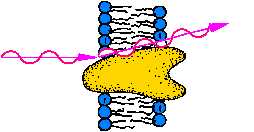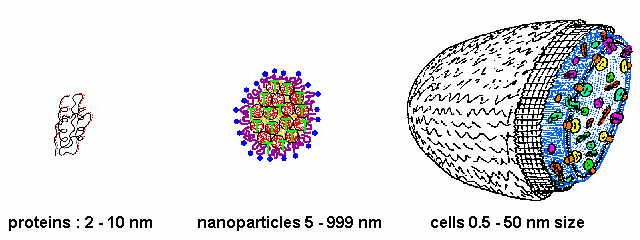 |
Membrane Pharmacy Structure DynamicsResearch group : Priv.Doz. Dr. Thomas NawrothNanoparticles |
 |
Membrane Pharmacy Structure DynamicsResearch group : Priv.Doz. Dr. Thomas NawrothNanoparticles |

- BioNanoparticles for therapy, imaging and diagnosis of cancer and other diseases lead an entrapped or bound therapeutic or diagnostic target material (T) to the area of interest, e.g. a tumor. The destination may be found by physical forces (magnetic) or with surface-bound antibodies (cell/tissue specific). BioNanoparticles may be: liposomes, magnetic liposomes, shell poly-Ferrofluids or polymers. As a consequence of the particle size (30-300 nm), the number of transported target molecules is very high: 106 - 109 / liposome in case of liposomes and poly-Ferrofluid applications.
- Motile Polymers and Membranes - a long term concept for technical application of molecular motion (Polymers and chimeric membranes, capable of active motion). Nanoparticles are structure components of those motile systems, which can supply the system with the energy required for motion, e.g. by magnetic forces.
The Nanoparticle applications, BioNanoparticles as well as motile polymers, use the following nanoparticles structure elements as components:
- Magnetic liposomes - Liposomes with an internal ferromagnetic iron oxide shell, entrapped magnetic domains or lipid-bound paramagnetic ions: These magnetic target carrier particles can be used for cancer therapy (neutron capture of entrapped boron compounds), magnetic drug targeting (drug entrapped in the liposome lumen), bioanalytics (analytical target signal, imaging), and biophysical experiments (membranes, Rheology, cellular traffic and transport). Magnetic liposomes of 30 - 300 nm size can be used for targeting in vivo, i.e. magnetic drug targeting MDT, and magnetic radiation targeting for X-rays (PXT, photodynamic X-ray therapy), neutrons (NCT, neutron capture therapy) and isotopes (PET, pertubed angular correlation).
- Liposomes - Hollow spheres of biogenic lipids : entrapping of drugs, radiation targets and other labels, immuno-reactive particles (with membrane anchored antigenes or antibodies), investigations on biological membranes (response to membrane potentials). Antibody liposomes of 30 - 300 nm size can be used for targeting in vivo, i.e. cell specific drug targeting MDT, and radiation targeting for X-rays (PXT, photodynamic X-ray therapy), neutrons (NCT, neutron capture therapy) and isotopes (PET, pertubed angular correlation).
- Ferrofluids - Nanoparticles constructed from massive iron oxide
spheres for magnetic drug targeting (cancer therapy), spectroscopy, magnetic
imaging (MR) and technical applications. Biocompatible Ferrofluids are
water-based and contain only endogenous or bio-inert materials. Small Ferrofluid
particles (single domains of 5 - 20 nm size) are suitable for hyperthermic
cancer therapy (overheating by RF-application). For biomedical target applications
the magnetic effect of simple Ferrofluids is too small. Thus only poly-Ferrofluids
of 30 - 300 nm size, depicting a large macroscopic magnetic moment and
magnetic structure generation, can be used for targeting in vivo,
i.e. magnetic drug targeting MDT, and magnetic radiation targeting for
X-rays (PXT, photodynamic X-ray therapy) and neutrons (NCT, neutron capture
therapy).